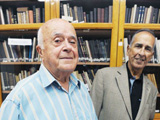|
|
TODAY.AZ / World news
Armenian students in Turkey have new books, 80 years later
05 October 2010 [11:07] - TODAY.AZ
 Armenian schools in Istanbul are to receive updated textbooks after a decision by Education Minister Nimet Cubukcu. The current textbooks have not been revised since the 1930s.
Armenian schools in Istanbul are to receive updated textbooks after a decision by Education Minister Nimet Cubukcu. The current textbooks have not been revised since the 1930s.Almost 24,000 books are to be distributed to students. Special permission is necessary to revise the content of the Armenian Language and Literature book, which has been the same since 1934. Minister Cubukcu broke a taboo by distributing new books to Armenian schools. Since books from the 1930s had been used in Armenian schools and their content had not been revised, all the schoolbooks were decades out of date.
Turkish and English CDs have been added to the updated schoolbooks, which were distributed for free. The biggest difficulty encountered in the revising was in the translation of books from Turkish into Armenian, because there were problems finding an interpreter with the capacity to make the translation.
The Turkish Armenian Minority Schools Teachers Fund, or TEAOV, worked to overcome this problem with the help of 80-year-old retired Armenian teachers. The hero behind the revising of the books is a member of Istanbul’s Armenian society, Varujan Turac. Turac, who is also a parent, has sent lots of letters to the ministry petitioning to renew the books.
TEAOV Chairman Garo Garabetyan, who followed all developments and prepared the books for publication with a community from Ankara and Istanbul, explained the difficulties. “We needed to get special permission from the Board of Education and Discipline to print the new books. It continued in the same way for many years. Ankara used to ask for 18 copies of each book with the approval of a certified interpreter and notary to determine whether the book was suitable or not.”
Aram Kamburyan, TEAOV secretary since 1974, claimed that they had problems with the Education Ministry in 1998. “We wanted to update the science and math books at the very least. We asked to translate the books that are used in Turkish schools. But the publication of the books was halted because some translation mistakes were found.”
Now the biggest problem for the foundation is the Armenian Language and Literature book used in high schools, because most of the writers of the book have died. Therefore it is not known how the content of the updated book will be prepared. Special permission is necessary to renew the content and publish the books. The book currently used, “Nor Tankaran” (New Museum), was published in 1934; the writer is Hrant Asadur.
3,000 students, 300 teachers
Although there are many historical Armenian schools in Istanbul, most of these schools have been closed because of the dwindling number of students. Istanbul’s Armenian community, which has a population of 50,000, has 16 schools. Only two of these are high schools. The number of Armenian students system-wide is 3,000, with 300 teachers. Since there is no department of Armenian Language and Literature at Turkish universities, teachers teach students what they have learned from their families.
Garabetyan said their schools were behind the times. “We have tried to do our best; this is all we can do. Our teachers’ knowledge of academic Armenian is insufficient; something should be done about the issue as soon as possible. Even if the borders open, we cannot bring teachers from Armenia. But with our foundation’s budget we can send students to departments of western Armenian language at universities in Yerevan. The eastern dialect of Armenian is spoken in Armenia but the Istanbul-based western Armenian is the one spoken by most Armenians worldwide.”
Weak in Turkish
According to Garabetyan, Armenian language is not the only difficulty in Armenian schools. At the same time, there are problems with the Turkish language. “This problem is gradually being overcome,” said Garabetyan. “The main reason for this problem is Turkish deputy principals appointed to Armenian schools. Even though the principals of the schools are Armenian and their title is higher, these Turkish deputy principals were the only ones who were the decision-makers. The Armenian principals did not have a chance to influence the education. This is why Turkish language remained weak, just like Armenian. But this problem is being solved.”
Kamburyan said TEAOV was founded in 1965. “Teachers who used to teach in Armenian schools in those years were not given their social security rights. They were not civil servants. We wanted to secure their rights.”
He said among the other Armenian foundations, TEAOV was the first to obtain the right to possess property. “In the first year of the association, a lawyer named Garabet Ersan filed suit for the association and won. Therefore, we have an autonomous status among Istanbul’s Armenian foundations.”
/Hurriyet Daily News/
URL: http://www.today.az/news/regions/74505.html
 Print version
Print version
Views: 1947
Connect with us. Get latest news and updates.
See Also
- 02 January 2026 [22:24]
Abu Dhabi sets record for longest fireworks display - 02 January 2026 [21:55]
Iran offers advanced weapons to foreign states in exchange for cryptocurrency - 02 January 2026 [11:05]
Switzerland declares national mourning after deadly fire at resort - 02 January 2026 [10:00]
UN Climate Change Conference COP31 to be held in Antalya in November 2026 - 02 January 2026 [09:00]
China completes Africa's first desert railway - 02 January 2026 [08:00]
Biopharmaceutical complex to be built in Kazakhstan - 01 January 2026 [22:22]
MTV ceases broadcasting in Europe - 01 January 2026 [21:19]
Zakharova: West's taxpayer money used to kill civilians - 01 January 2026 [20:40]
BTS announces release date for new album - 01 January 2026 [19:47]
UK opposition minister faces scrutiny over ties to sanctioned Russian oligarch Abramovich
Most Popular
 Five years of reliable partnership - Azerbaijani gas as a pillar of EU energy security
Five years of reliable partnership - Azerbaijani gas as a pillar of EU energy security
 First VP Mehriban Aliyeva shares post on Day of Solidarity of World Azerbaijanis and New Year
First VP Mehriban Aliyeva shares post on Day of Solidarity of World Azerbaijanis and New Year
 Gulf nations offer support for Yemen’s government and Saudi security
Gulf nations offer support for Yemen’s government and Saudi security
 Netherlands Embassy in Baku congratulates Azerbaijan on Solidarity Day and New Year
Netherlands Embassy in Baku congratulates Azerbaijan on Solidarity Day and New Year
 Why Fico’s EU critique reflects Slovak politics more than European reality
Why Fico’s EU critique reflects Slovak politics more than European reality
 Porsche recalls cars over camera issue
Porsche recalls cars over camera issue
 Georgia eyes Baku–Tbilisi–Kars rail finish in 2026 push
Georgia eyes Baku–Tbilisi–Kars rail finish in 2026 push
